Traditional resource planning assumes your projects, priorities, and team availability will stay the same.
It works great when everything goes according to plan. But how often does that actually happen?
One changed deadline, one team member out sick, or one client emergency, and your carefully crafted schedules start to collapse.
Enter Agile resource planning, where you work in flexible cycles and adapt to real-time changes. Here’s how to do it.
Traditional resource planning vs. Agile resource planning
| Traditional resource planning | Agile resource planning |
|---|---|
| Work mapped out weeks or months in advance | Short 1-2 week cycles |
| Changes are rare and difficult once plan is set | Expects rapid change by default |
| Built for predictability and stability | Regularly updates based on current situation |
| Overbooked teams and missed deadlines | Sustainable workloads and reliable delivery |
With traditional resource planning, you map out who does what, when they’ll do it, and how long it should take—often weeks or months before work begins. Once the plan is set, changes are rare and difficult.
Andy Culligan, CEO of purple path, puts it perfectly:
Traditional resource planning is built for predictability, not for pace.
This often leads to overbooked teams, missed deadlines, and frustrated clients when reality doesn’t match the original plan.
But Agile project resource planning expects rapid change by default.
Instead of locking in fixed schedules, you plan in shorter “sprint” cycles—typically one to two weeks—and regularly update projects based on what’s currently happening.
So, as Andy explains, if “roadmaps shift, funding rounds impact priorities overnight, and go-to-market timelines compress without warning,” you can quickly shift resources without derailing everything else.
This is exactly why Agile planning has become a survival tactic for modern service businesses.
While traditional planning assumes stability, Agile planning assumes disruption and gives you the flexibility to handle it.
How to do resource planning in Agile
Follow these five steps to build a resource planning system that keeps your projects and teams on track, even when things change.
Step 1: Plan using real-time capacity (guided by past utilization)
Agile resource planning combines current and historical capacity data to create a realistic picture of what your team can accomplish (and when).
This is different from traditional planning, which starts with deadlines and works backward.
The result?
More realistic timelines and fewer last-minute scrambles when someone gets overloaded or unexpected work comes in.
How to do it:
Start with Scoro’s “Resource Bookings” heatmap, which gives you a visual overview of your team’s capacity.
Choose to view capacity by percentages or booked or remaining hours. See who’s still available (anyone with white or green) and who’s fully or overbooked (red).
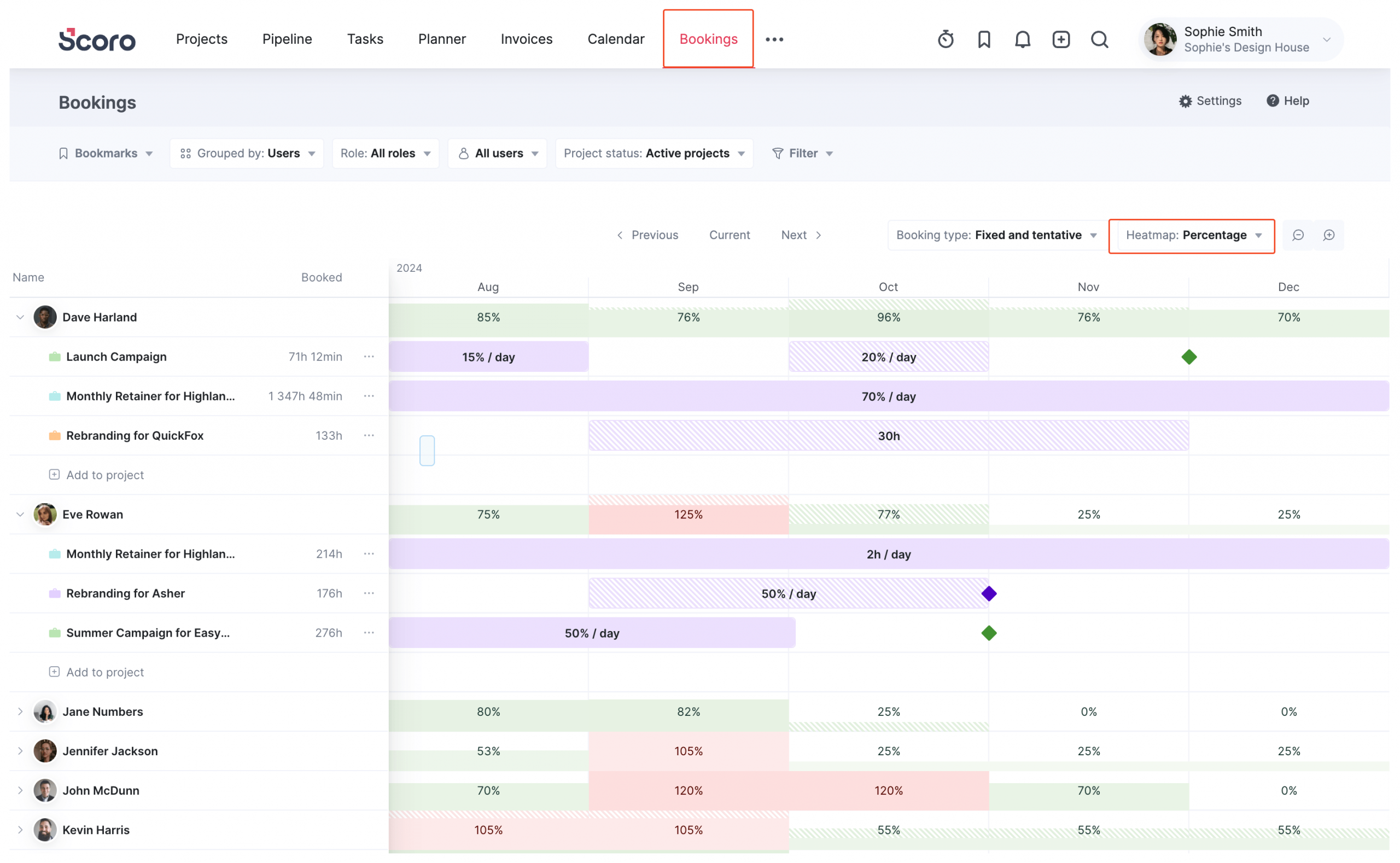
Then, compare those real-time resource utilization rates with past data in Scoro’s “Utilization” report.
Just click “Current month” and change it to the previous month.
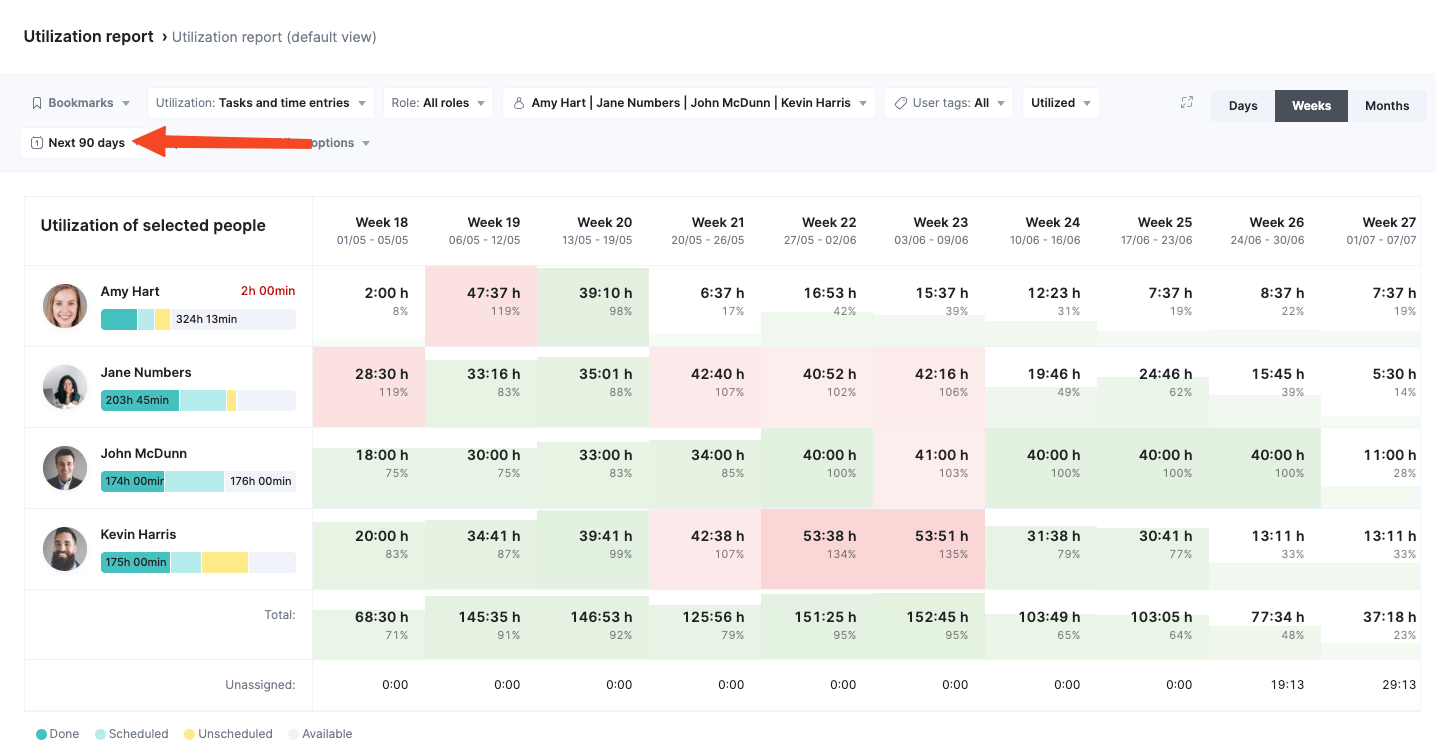
This way, you can make realistic decisions about workloads.
Say your designers historically run at 85% capacity. Instead of pushing them to the limit, you could outsource some work to avoid burnout, delays, or quality issues.
But you can give more work to a team that typically runs at 65% capacity without problems.
And leave at least 15%-20% capacity open on your team’s calendars.
As Zoe Blogg, Managing Director at Reboot explains, this creates a buffer for unexpected changes and things like “context-switching, internal meetings, and Slack that eat into actual delivery time.”
Step 2: Break down work into sprint-friendly chunks
Agile planning breaks work into smaller, more manageable pieces that you can move around as priorities shift without losing momentum.
Instead of planning every detail upfront, start with a general scope and create specific tasks as you go. This gives you the flexibility to adapt quickly when things change.
How to do it:
Zoe recommends splitting big milestones (like creating a new brand strategy or redesigning a website) into specific, outcome-focused assignments that take one or two days each, like:
- Write creative brief
- Conduct competitor analysis
- Draft initial concepts
- Present first round of visuals to client
“Instead of ‘design,’ ‘copy,’ ‘upload,’ think, ‘Complete outreach to 20 journalists’ or ‘Go live with updated pricing page,'” she says.
This outcomes-focused approach makes it easier to reassign work when needed because anyone can understand what needs to be accomplished.
Once you have your task list, add them to Scoro’s “Planner.”
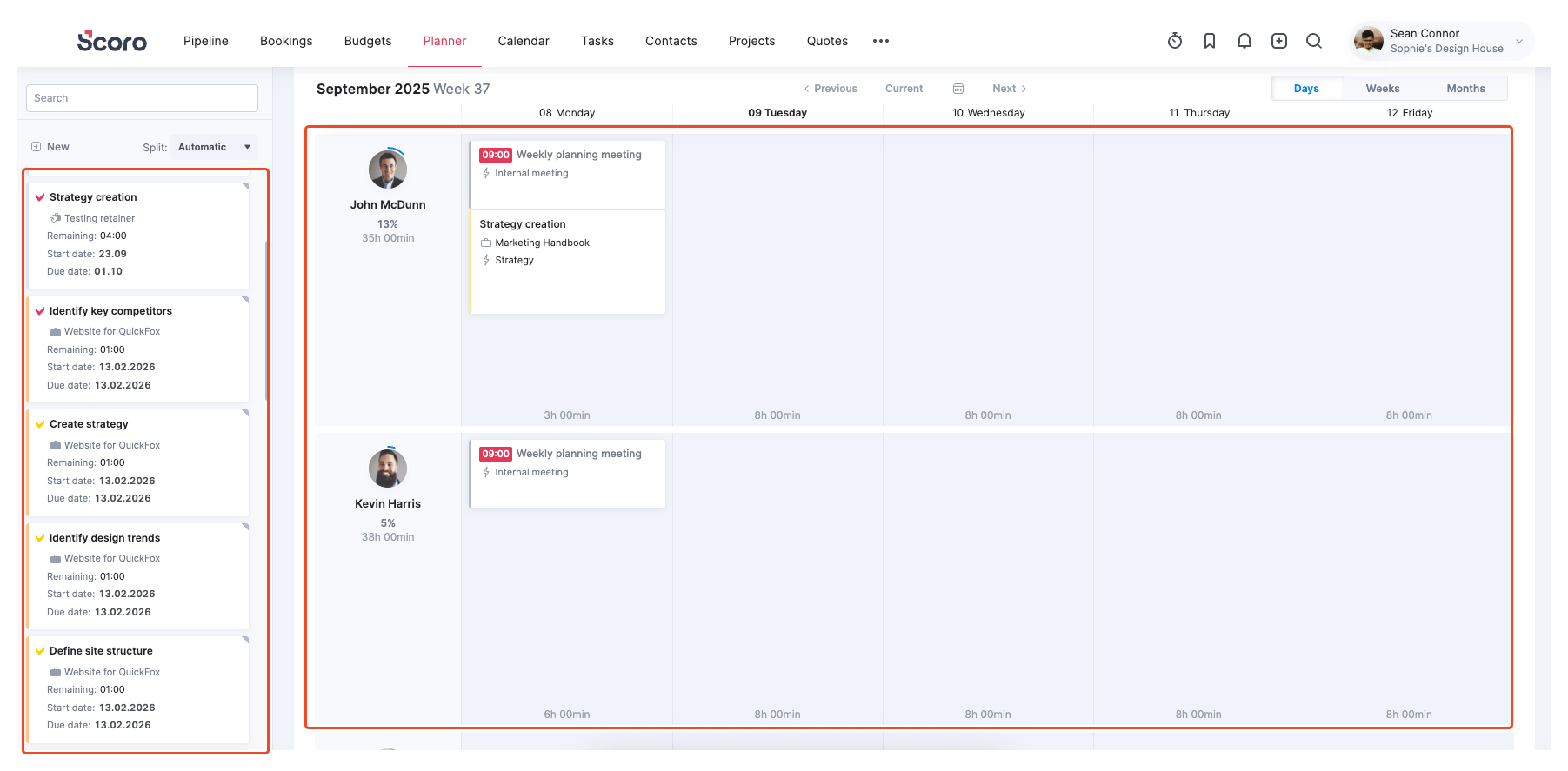
Here, you can easily drag and drop assignments between team members or time periods. And quickly spot dependencies and potential bottlenecks before they impact deadlines.
Step 3: Reprioritize based on urgency and value
The central question of Agile planning is this:
What creates the most value right now, given our current constraints and changing business needs?
Instead of rigidly sticking to original timelines, you regularly reassess and adjust priorities based on what matters most today. This keeps your team focused on high-impact work while staying responsive to client needs.
How to do it:
Use a prioritization framework to objectively decide when to tackle different projects and tasks.
For example, Scoro’s project priority matrix categorizes work based on urgency and importance. So you can easily decide where work should fit in your schedule.
Give high-importance/high-urgency projects immediate attention. And push low-importance/low-urgency items to later sprints or cut them entirely.

Freia Muehlenbein, agency growth consultant at Be Reyt, has helpful advice:
Be clear internally how you rank the level of priority for work. Create internal guidance that everyone is aware of and ensure your account managers inform your clients on how these decisions are made so there are no surprises.
She also recommends distinguishing between “predictable work” (like scheduled project phases or retainer tasks) and “less predictable work” (additional client requests, new tickets, or scope changes).
To identify high-priority, unscheduled tasks across all your projects, use Scoro’s Planner and filter using the “Priorities” tab.
The system also lets you sort by client, project phase, or deadline, letting you quickly zero in on what needs your attention.
From here, you can easily drag and drop tasks to available team members.
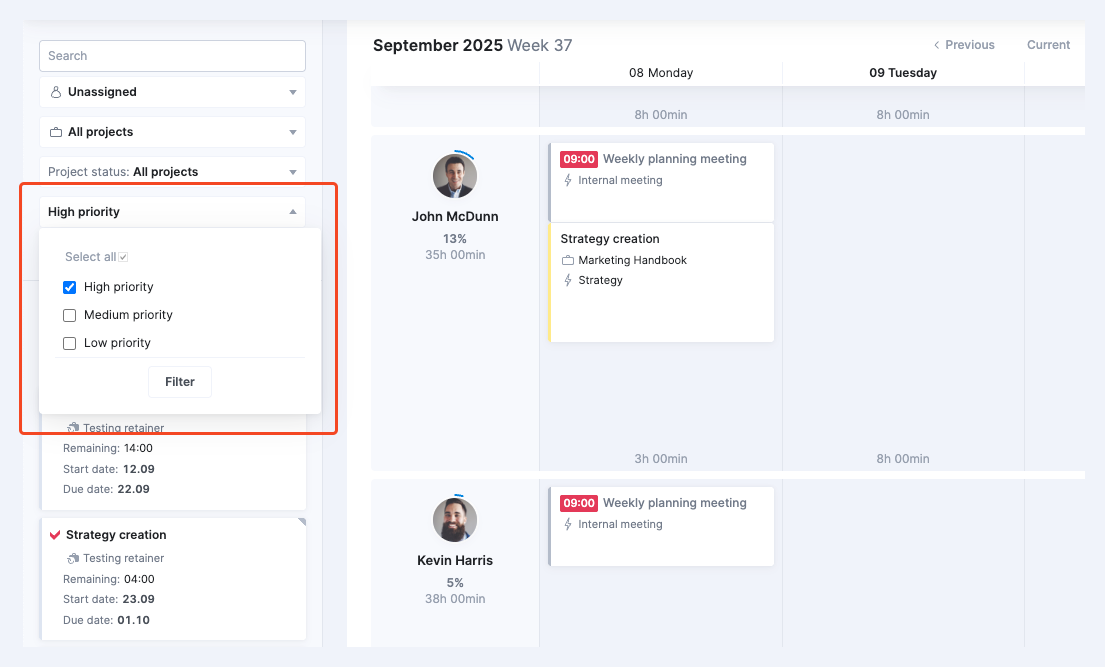
Step 4: Assign based on fit, but expect change
The Agile way of working recognizes that priorities and people’s availability can shift quickly.
So you allocate resources based on who has the right skills and capacity right now, while having a back-up plan (or two or three) to handle any changes.
This keeps work moving efficiently.
And don’t just look at job titles and availability when building your team.
As Restartt co-founder George Chasiotis explains:
I assign based on context and momentum. Who already has the context to move fast? If you understand the problem and have headspace to act, it’s yours.
Use Scoro’s “User tags” filter to find the right person based on their skills, availability, and other key criteria.
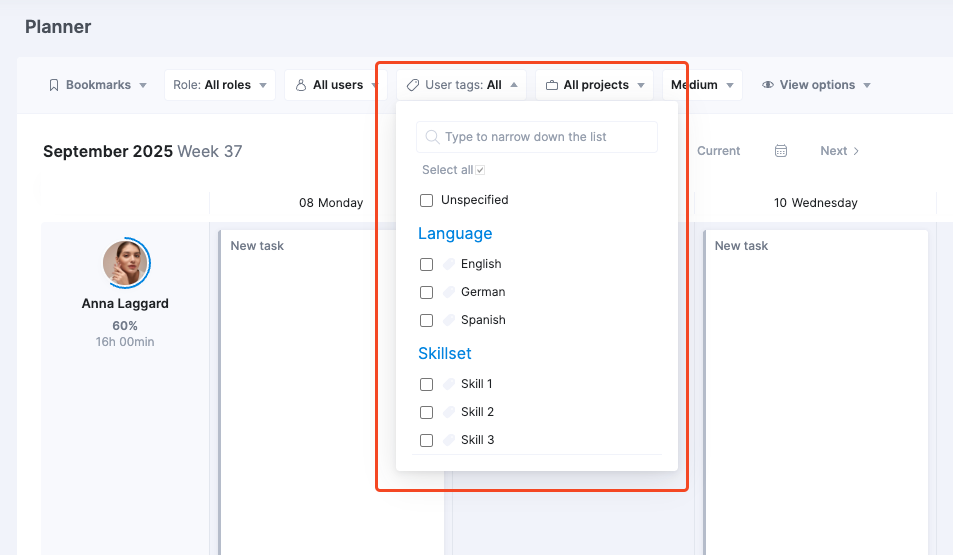
Step 5: Re-sync often (not just at major milestones)
Traditional teams sync at major milestones—often weeks or months apart.
But by then, small problems have grown into big crises, budgets may have blown out, and team members are stressed or confused about priorities.
To avoid these issues, Agile teams use frequent, brief check-ins to catch problems early and keep everyone moving in the same direction.
These regular touchpoints let you spot bottlenecks, shifting priorities, and resource conflicts before they derail your timeline (and your bottom line).
But, as Freia explains:
There’s a sweet spot between too many check-ins (which is a sign of low trust and bad systems) and too few check-ins (which leads to missed deadlines and profitability issues)
Stick to short, daily stand-ups for immediate blockers and weekly planning sessions for bigger-picture adjustments.
How to do it:
At minimum, hold a weekly project resource review meeting focused on three key questions:
- Which tasks are on track?
- Who’s overbooked?
- What priorities have shifted since last week?
The goal is to move forward with clarity and catch issues while they’re still small and fixable. And this approach gives you a regular pulse check without overwhelming your team with too many meetings.
Here’s how George keeps his agency on track:
Every team has a weekly check-in with their lead to review workload, go over backlogs, and make sure everyone’s aligned on the right priorities. The leads from different teams also sync to ensure everyone’s supporting each other and solving problems.
Guide your discussions using data from Scoro’s “Project list” to see an overview of all your projects and their progress (as shown by the blue and red progress bar).
Customize metrics as needed—like start and due dates, profit, expenses, margin, total done, and scheduled to do—so you can quickly see where you stand.
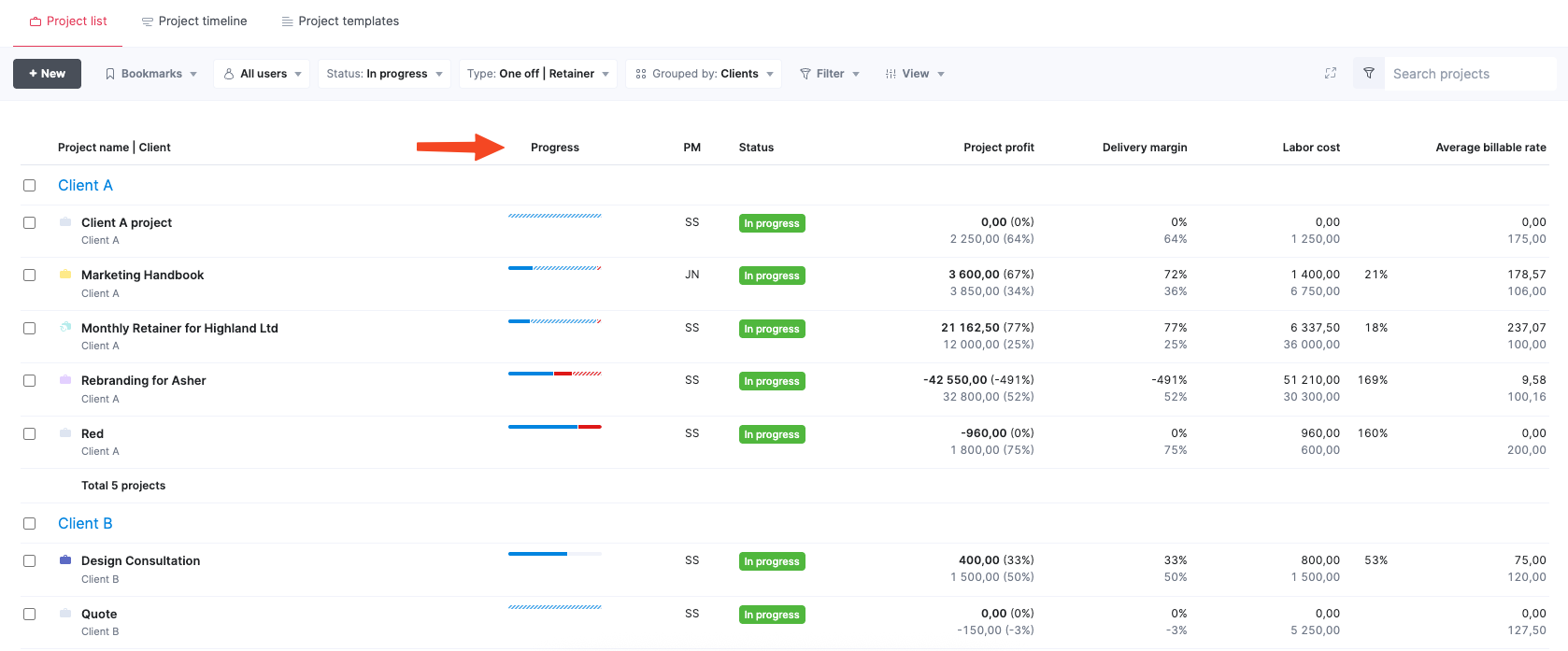
Get started with Agile resource planning
Resource planning in Agile projects gives you the flexibility to adapt when priorities shift. So you can stay profitable and keep teams productive.
Scoro makes it easy to do exactly that.
Take Design de Plume. The creative agency had limited visibility into team utilization and was stuck assigning work based on availability rather than expertise.
With Scoro, they transformed how they plan projects and allocate work, increasing profitability by over 20%.
“We wanted the best people on the best projects that were the best fit for them,” explains Meggan Van Harten, Co-CEO. “We now have the insights to make the right staffing decisions. Our team is working on what they’re best at, which improves job satisfaction and project outcomes.”
Ready to embrace Agile? Try Scoro for free for 14 days.






